HP EliteBook 8760w: Color, So Dreamy
by Dustin Sklavos on August 25, 2011 2:30 AM ESTWorkstation Performance
Since we're working with a mobile workstation in the HP EliteBook 8760w, it's worth testing it in workstation-based performance metrics. Note that for these our only reference points are desktops; as we get more mobile workstations in we'll be able to improve the amount of data we have to the point where we can eventually split these off into mobile and desktop charts.
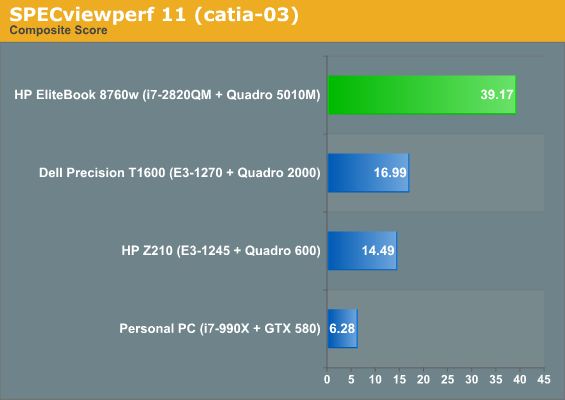
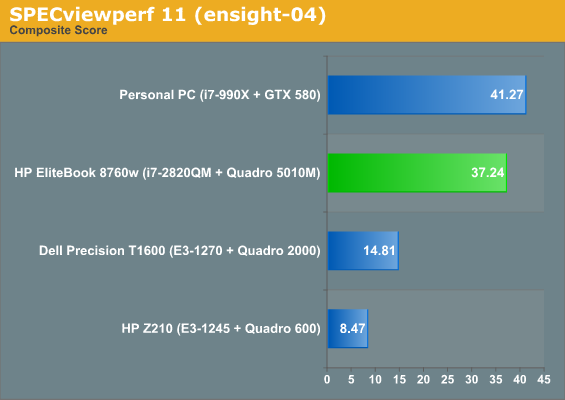
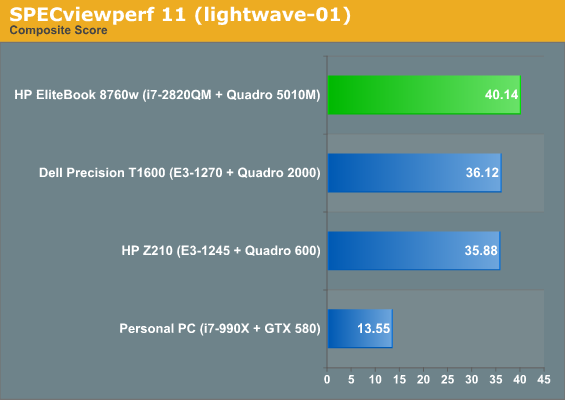

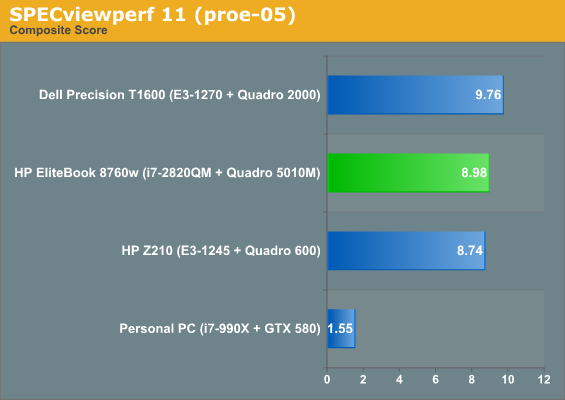

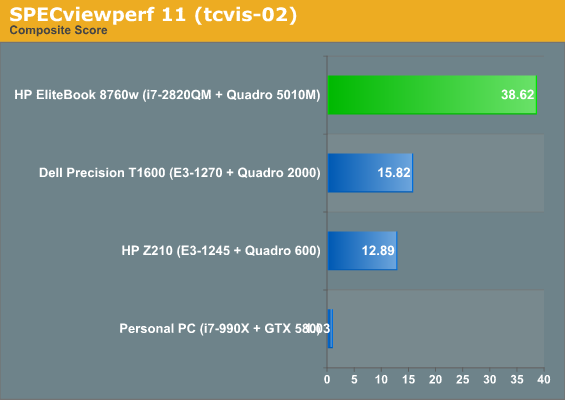
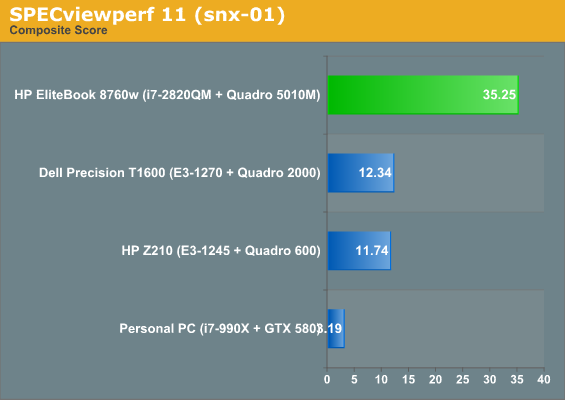
In SPECviewperf 11, the 8760w's Quadro 5010M comes into its own and runs roughshod over the other cards. That's fair: the 5010M boasts twice as many CUDA cores as the Quadro 2000 and four times as many as the Quadro 600, more than making up any performance deficit resulting from the faster processors in the desktop workstations. The 5010M is in fact likely to be as fast as or faster than any desktop Quadro currently offered on NewEgg.
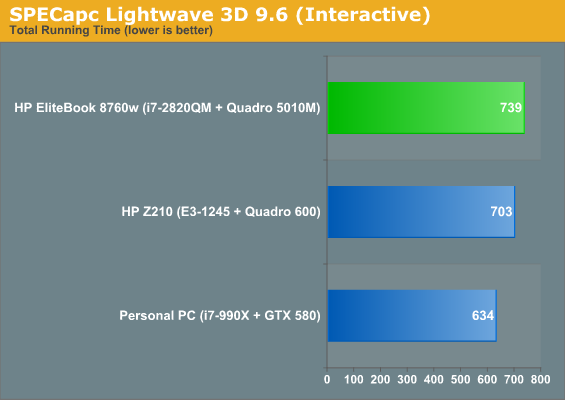
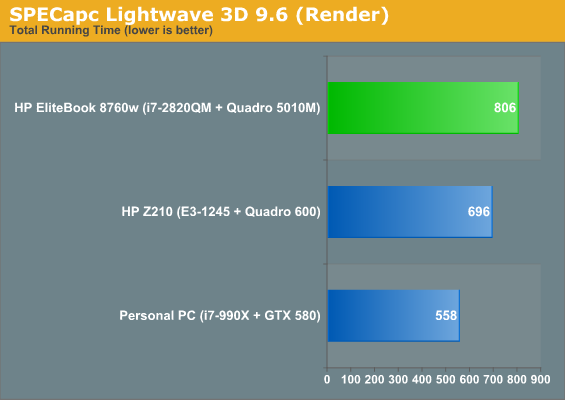
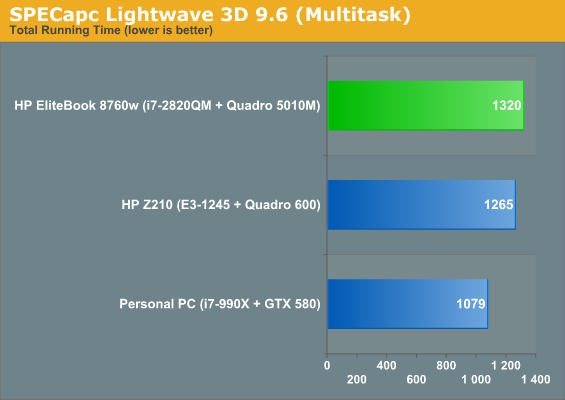
SPECapc for Lightwave 3D 9.6 shows more excellent results for the HP EliteBook 8760w and proves it's more than capable of offering adequate performance for users who need a mobile workstation.
Our third benchmark is Premiere Pro Benchmark for CS5 (run in CS5.5 without issue), and as I mentioned in my review of HP's Z210 SFF desktop, I'm still not 100% sold on this benchmark. If you agree or disagree on its inclusion, or have another workstation-class benchmark to suggest, please sound off in our comments.
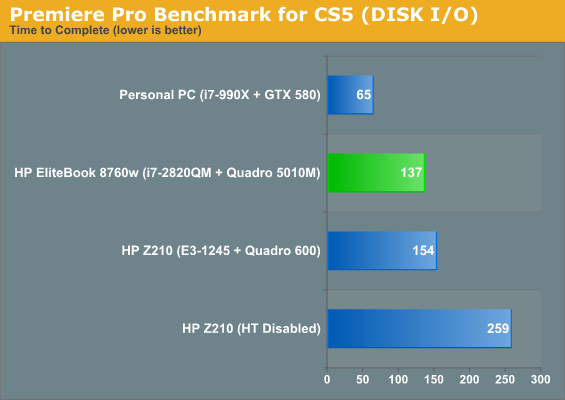
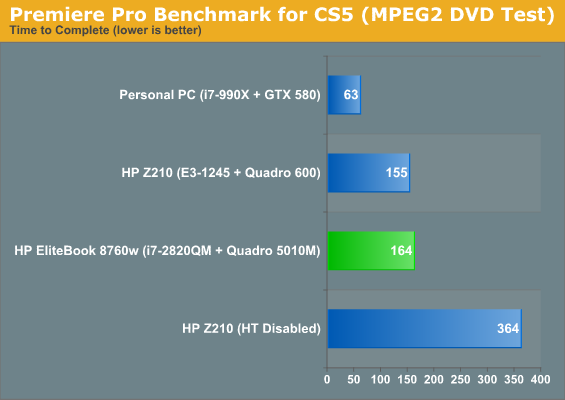
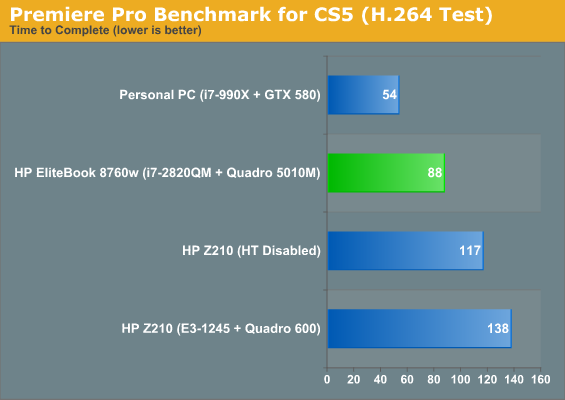
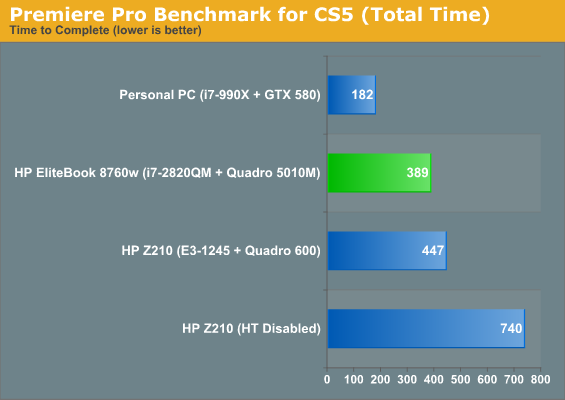
Adobe Premiere Pro unsurprisingly favors as much CPU power as you can throw at it, and as a result the quad-core systems can't really compete with an i7-990X. The 8760w does put in a great showing, though, possibly owing to the speedy Micron C300 SSD which runs faster than the Intel X25-M in the HP Z210 SFF.










83 Comments
View All Comments
Impulses - Thursday, August 25, 2011 - link
HP should showcase it at retail to show people what they're missing... You can't even buy desktop IPS screens at a brick & mortar store anymore, it's sad. I'm about to but three 1920x1200 displays (ZR24W or possibly the new Dell if I can get a discount) and I'm already dreading the day one of them dies, because I know I'll have even less options by then.Roland00Address - Thursday, August 25, 2011 - link
Ever since LG has made E-IPS screens you been seeing a steady decrease in prices for ips screens. This has accelerated now that LED monitors are the norm.Yes you can get IPS at B&M, and you can get them for $150 to $300 dollars. Currently microcenter has lg ips 226v for $159, bestbuy has lg ips 236v for $199, frys has lg ips 231p for $199. LG also designs the panels that other manufactures then use, Asus, Dell, HP, and Viewsonic all have ips monitors, and some of the monitors are in various B&M.
Dustin Sklavos - Friday, August 26, 2011 - link
The problem is that these eIPS screens are 6-bit color and not 8-bit. I think they're still a major improvement on TN and would love to see the market shift over to them, but they're not as good as full-on IPS panels (although I still very much prefer *VA panels for their deeper, inkier blacks.)DanNeely - Friday, August 26, 2011 - link
While they're better than TN, I dislike *VA for blackcrush. That's when the lowest 5-10% of the brightness all appear equally dark from head on, but pop up when looking from an angle. Hubble galaxy pictures tend to demonstrate this effect well since the edges of the galaxy generally fade down to the background black in a relatively smooth fashion.Dustin Sklavos - Friday, August 26, 2011 - link
Honestly I found my ZR24w (IPS) to crush blacks far worse than my LP2465 (*VA). A decently calibrated VA panel can produce fine detail in the darks, but the shimmer on an IPS panel's black drives me insane.DanNeely - Friday, August 26, 2011 - link
Odd. My NEC 2090's and 3090 are blackcrush free. I have an HP panel I never tested for it, will take a look when I get home. I've never noticed anything that could be called shimmer on my screens; but I've never looked either...velis - Friday, August 26, 2011 - link
Yep, agree with Dustin. This monitor is WAY better than my U2711, not to mention that it consumes A LOT less power. The U2711 heats like it was intended to (do only that) while this monitor stays perfectly cool. Plus backlight uniformity issues and bad out-of-factory colors - had to calibrate to get anything resembling good colors out of it.$500 + $200 = $700 * resdiff (1,78) = $1250, not $2500 (for the same res)
I see no reason why the panel should be different except to keep the DPI lower on desktop, but I said I dream of a desktop variant of this same monitor == same panel.
Much more competitive market == much lower prices. Limited to mfg options = higher prices.
Agree about targeted pricing for a market, but I don't agree with the premium HP charges to this market.
As far as I'm concerned, I super love this display and would gladly see it duplicated for my desktop. I hated the U2711 for its heating before, now I just do most of my work on this one... But I do agree a comparison would be in order. Mostly a $200 1080p desktop IPS will more than adequately serve as the primary screen for a crappy 1080p laptop. The dreamcolor is definitely expensive, but IMO it's worth it at this price point. Not so much at $2500 :P
velis - Friday, August 26, 2011 - link
Forgot to mention:You really have to see this monitor with your own eyes to see how good it really is. The colors are just so ... smooth ... I'm not sure it can even be described. Like the display was soothing your eyes as you look at it.
Not to mention it's uniformity which compared to other LCDs is just about what LCD geometry is to CRTs.
wsaenotsock - Thursday, August 25, 2011 - link
Well, looks like the workstation & enterprise products are finally succumbing to the market forces behind 16:9 panels. Oh, and simultaneously charging more for the IPS upgrade as well. Margins must be really tight.alpha10 - Thursday, August 25, 2011 - link
I would like to see the 2 full HD screens compared for the 8760w.I did a comparison with the 8560w, and wasn't impressed by the Dreamcolor, the "grain" or "sparkle" was too much for me, the regular screen looked a lot cleaner and nicer. Obviously the Dreamcolor has much better viewing angles, but who cares about this when working and looking at the screen at an optimal position? I also found the over-saturated colors to be too much. For a web designer all the colors were too strong, I had to set the color profile down to sRGB to get correct colors.
I ended up buying the 8760w with the regular screen, after a calibration using Spyder 3 Elite, the colors are perfect, gone is the blue tint that most TN panels have.